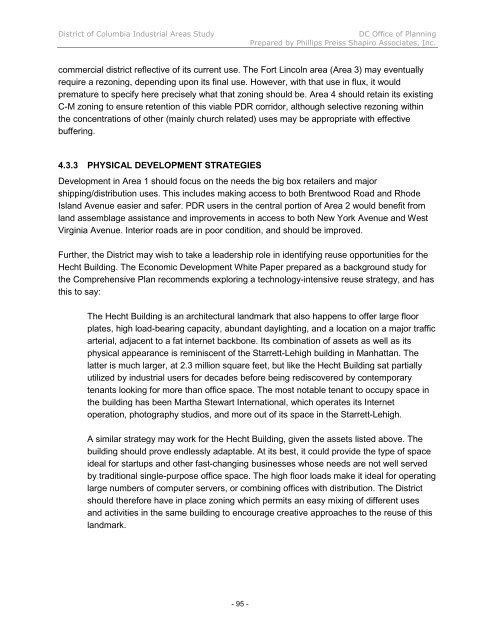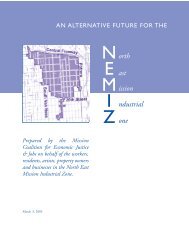INDUSTRIAL LAND IN A POST-INDUSTRIAL CITY District of ...
INDUSTRIAL LAND IN A POST-INDUSTRIAL CITY District of ...
INDUSTRIAL LAND IN A POST-INDUSTRIAL CITY District of ...
Create successful ePaper yourself
Turn your PDF publications into a flip-book with our unique Google optimized e-Paper software.
<strong>District</strong> <strong>of</strong> Columbia Industrial Areas Study DC Office <strong>of</strong> Planning<br />
Prepared by Phillips Preiss Shapiro Associates, Inc.<br />
commercial district reflective <strong>of</strong> its current use. The Fort Lincoln area (Area 3) may eventually<br />
require a rezoning, depending upon its final use. However, with that use in flux, it would<br />
premature to specify here precisely what that zoning should be. Area 4 should retain its existing<br />
C-M zoning to ensure retention <strong>of</strong> this viable PDR corridor, although selective rezoning within<br />
the concentrations <strong>of</strong> other (mainly church related) uses may be appropriate with effective<br />
buffering.<br />
4.3.3 PHYSICAL DEVELOPMENT STRATEGIES<br />
Development in Area 1 should focus on the needs the big box retailers and major<br />
shipping/distribution uses. This includes making access to both Brentwood Road and Rhode<br />
Island Avenue easier and safer. PDR users in the central portion <strong>of</strong> Area 2 would benefit from<br />
land assemblage assistance and improvements in access to both New York Avenue and West<br />
Virginia Avenue. Interior roads are in poor condition, and should be improved.<br />
Further, the <strong>District</strong> may wish to take a leadership role in identifying reuse opportunities for the<br />
Hecht Building. The Economic Development White Paper prepared as a background study for<br />
the Comprehensive Plan recommends exploring a technology-intensive reuse strategy, and has<br />
this to say:<br />
The Hecht Building is an architectural landmark that also happens to <strong>of</strong>fer large floor<br />
plates, high load-bearing capacity, abundant daylighting, and a location on a major traffic<br />
arterial, adjacent to a fat internet backbone. Its combination <strong>of</strong> assets as well as its<br />
physical appearance is reminiscent <strong>of</strong> the Starrett-Lehigh building in Manhattan. The<br />
latter is much larger, at 2.3 million square feet, but like the Hecht Building sat partially<br />
utilized by industrial users for decades before being rediscovered by contemporary<br />
tenants looking for more than <strong>of</strong>fice space. The most notable tenant to occupy space in<br />
the building has been Martha Stewart International, which operates its Internet<br />
operation, photography studios, and more out <strong>of</strong> its space in the Starrett-Lehigh.<br />
A similar strategy may work for the Hecht Building, given the assets listed above. The<br />
building should prove endlessly adaptable. At its best, it could provide the type <strong>of</strong> space<br />
ideal for startups and other fast-changing businesses whose needs are not well served<br />
by traditional single-purpose <strong>of</strong>fice space. The high floor loads make it ideal for operating<br />
large numbers <strong>of</strong> computer servers, or combining <strong>of</strong>fices with distribution. The <strong>District</strong><br />
should therefore have in place zoning which permits an easy mixing <strong>of</strong> different uses<br />
and activities in the same building to encourage creative approaches to the reuse <strong>of</strong> this<br />
landmark.<br />
- 95 -












